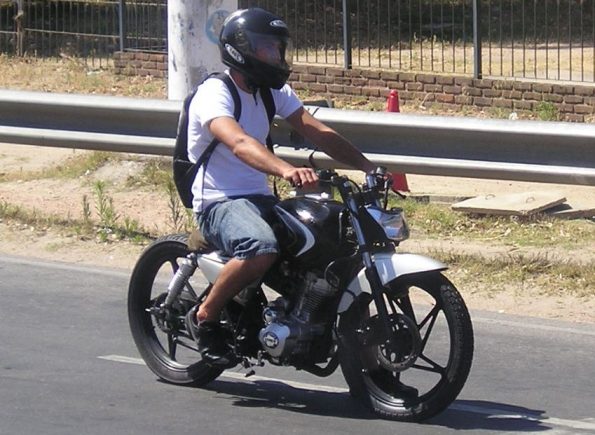In summer you see many motorcyclists riding wearing shorts, thongs and t-shirts not realising (or not caring) that their skin versus tarmac is not a contest that skin will win. But, it’s hot. Really hot. Summer is the time you want to be out on your bike, having fun rides in dry, clear weather.

This should not be your clothing in summer
Sensible bikers wear protective clothing: boots, trousers, jacket, gloves and (preferably) a back protector.
When it’s 30 degrees, all this insulation can make us very uncomfortable. Many bikers will know just how uncomfortable it can be to suit up, get the bike started and get moving to get some airflow to cool down. Even a minute without any airflow can be stifling.
However, there are tips that can keep you cooler.
Summer bike clothing
If you can afford it, a separate set of protective gear for the summer is a must. Because it’s lighter weight than the winter protective gear it’s sometimes a bit cheaper, too. If you’re buying gear make sure it comes with vents that can be opened and closed. Textiles such as air mesh Kevlar are a better option than leather in hot weather as they can be engineered to be more breathable.
If you don’t mind layering up, then you can use summer gear in autumn and winter by wearing a layer underneath which means you might only need one set of protective gear.
Ventilation and wetting
Make sure you have all the vents open in your jacket, pants and helmet. This allows the air to take away heat using convection – it’s called wind chill. This doesn’t work once the air temperature gets to around 34 degrees Celsius – wind at that temperature heats up your body. In this case you’ll want to wear wind deflecting material, but ensure that you are wearing clothing that allows you to sweat.
Soak your t-shirt in cold water then put your jacket over that; as the t-shirt dries it will keep you cool and stop you sweating so much. We lose heat by evaporating water from our bodies, and if that comes from a pre-soaked t-shirt, then your body doesn’t need to sweat out its precious water reserves as quickly. You can also purchase specialist cooling vests.
Sunblock
Remember to put sunblock on any part of your body that is exposed. Usually this is the back of your neck and sometimes your wrists if your jacket rides up beyond the end of your gloves.
Fighting dehydration
It’s quite easy to become dehydrated riding a motorbike, and this dulls your reactions and distracts you. Once you start feeling thirsty you area already dehydrated. You will need between 600ml and 1.2 litres of water per hour if it’s hot. You can tell if you’re drinking enough by looking at the colour of your urine: if it’s pretty clear, you’re good; if it’s yellow you’re not.
Avoid drinking coffee or Coke as they are diuretics and cause you to lose water.
If you start getting a headache while riding then it’s likely you are becoming too hot and you have gone past the initial stages of dehydration. You may be at risk of heat exhaustion.
A hydration pack with a hose is one solution for your thirst, or stop every hour and take a drink. It’s best not to drink iced water if you are dehydrated. When very cold water hits your stomach your body works to try to compensate for it, and this can make you hotter.
Hot bikes
Some bikes are hotter than others. Riding a naked bike at slow speeds can feel like you’re sitting astride a furnace. If you need to take a route that could have backed-up traffic, is there an alternate route? Can you filter through the traffic to keep some airflow?
Stopping for a rest, or at the lights
Turn your bike off at red lights if you know that you might be there a minute or two.
Remember to take regular breaks in the heat. Turn the bike off, take off your jacket, then sit in the shade. If you start feeling sick or dizzy, get cramp, a headache or blurred vision than you may be suffering heat exhaustion/heatstroke and/or electrolyte loss. Eating some healthy food and getting some water into will make you feel better, but it could be more than half an hour before you start to come right, so take care.
Melting tar
When the road surface reaches 50C the tar starts to soften. Eventually it melts, making it a nightmare for motorcyclists. How much it melts depends on the type of road and how worn it is. When road crews have repaired cracks can create long ribbons of slippery, melting tar. Try to cross these at a 90-degree angle.
